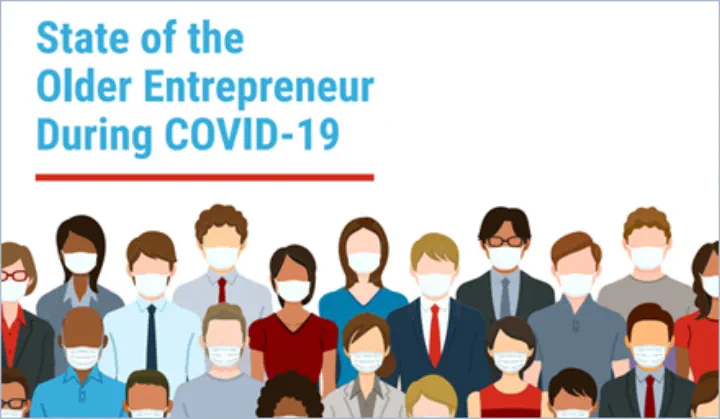
State of the Older Entrepreneur During COVID-19
Older entrepreneurs are the majority of small business owners, yet they faced outsized challenges this year, including business closures, depletion of personal assets, and weakened revenue streams. These impacts were even more pronounced for older entrepreneurs of color.
The economic toll of COVID-19 on America's small businesses is acute and ongoing. Uncertainty related to public health protocols, consumer demand, technology adoption, supply chains, and government relief programs has upended the operating environment for small firms that frequently lived on the financial margins even before the pandemic.1 This is especially true for small firms owned by people 45 and older, which saw significant closures in spring 2020 and whose numbers remain well below pre-pandemic levels. Among people of color, the drop was even more stark.2
Business ownership has the potential to be a financial bulwark, especially for business owners of color.3 Age 45+ business owners entered the pandemic with much stronger financial cushions than similar age employees and business owners under the age of 45. However, our analysis of survey data for small employer firms4 collected in late 2020 and detailed interviews with 25 business owners5 finds that older small business owners, and particularly business owners of color, had difficulty accessing funds to stay open and have experienced significant personal financial hardship during the pandemic. The future of these businesses—and the owners' personal financial lives—is particularly salient, given that they are the lion's share of small businesses.
Overall, we find:
- Business owners, particularly those aged 45+, tend to hold more assets and savings than their traditionally employed peers. However, the COVID-19 pandemic has caused significant financial strain, which has not only impacted their businesses but has also eaten into their personal assets.
- Going into the pandemic, not all older small business owners were starting with similar financial cushions. Self-employed people of color had fewer assets and savings than their white counterparts. Their firms were also less likely to be financially healthy.
- During the pandemic, older entrepreneurs have seen a more dramatic decline in active business ownership than their younger counterparts. The drop has been even steeper for older entrepreneurs of color and particularly pronounced among Asian business owners.
- Applications for PPP funds among older small business owners were predominantly for small-dollar loans. Businesses owned by people of color were less likely to receive the full amount of PPP funding sought compared to their white peers.
- Older small business owners continue to face challenges operating their businesses. Most would like to seek additional government aid beyond what they received in 2020.
Endnotes
- Diana Farrell, Chris Wheat, and Chi Mac, 2020. A Cash Flow Perspective on the Small Business Sector. JP Morgan Chase & Co. Institute. Available at: https://www.jpmorganchase.com/content/dam/jpmc/jpmorgan-chase-and-co/institute/pdf/institute-cash-flow-perspective-small-business.pdf; Federal Reserve Banks, 2021. Report on Employer Firms. Available at: https://www.fedsmallbusiness.org/~/media/FedSmallBusiness/ files/2021/2021-sbcs-employer-firms-report. Return to 1
- Aria Florant, Nick Noel, Shelley Stewart, and Jason Wright, 2020. COVID-19: Investing in Black Lives and Livelihoods. McKinsey & Company. Available at: https://www.mckinsey.com/industries/public-and-social-sector/our-insights/covid-19-investing-in-black-lives-and-livelihoods; Claire Kramer Mills and Jessica Battisto, 2020. Double Jeopardy: COVID-19’s Concentrated Health and Wealth Effects in Black Communities. Federal Reserve Bank of New York. Available at: https://www.fedsmallbusiness.org/~/media/FedSmallBusiness/files/2020/ DoubleJeopardy_COVID19andBlackOwnedBusinesses. Return to 2
- Robert W. Fairlie, 2004. “Does Business Ownership Provide a Source of Upward Mobility for Blacks and Hispanics?” In Public Policy and the Economics of Entrepreneurship, Douglas Holtz-Eakin and Harvey S. Rosen eds., 153-79. Cambridge, MA, London England: The MIT Press. Fairlie finds that self-employed black and Hispanic men have greater earnings over time than their minority wage/salary counterparts. Available at: https://ssrn.com/abstract=1497271. Return to 3
- Small employer firms have between 1 and 499 full- and part-time employees, in addition to the owner, on payroll. Return to 4
- In 2020, the AARP Work & Jobs team and the New York Fed conducted interviews of 25 business owners ages 45 and older. See: Jeffrey Love, 2021. Supporting Small Business Owners 50+: March 2021. https://doi.org/10.26419/res.00453.001. Available at: https://www.aarp.org/research/topics/economics/info-2021/assessing-needs-small-business-owners.html. Return to 5
